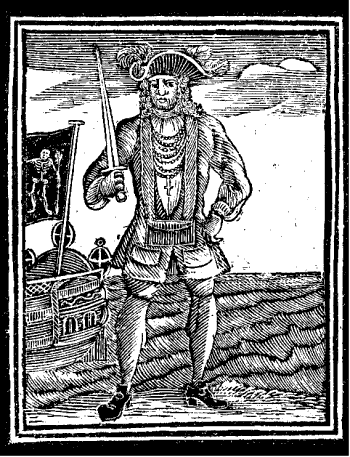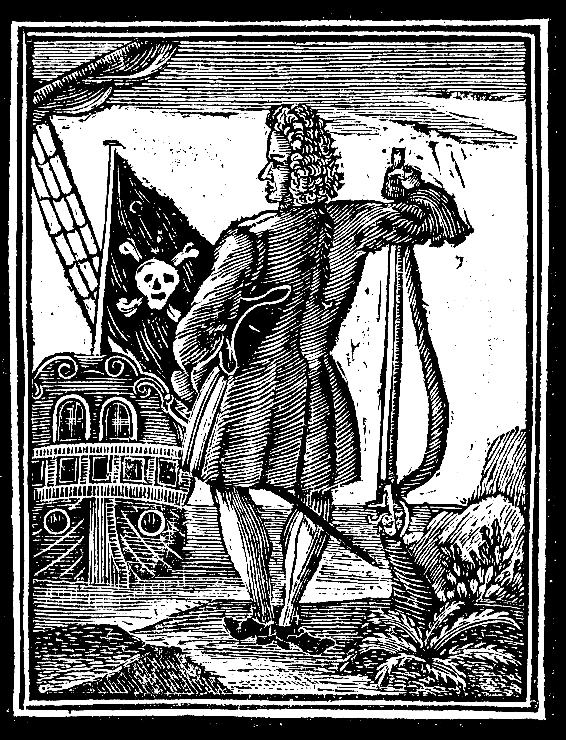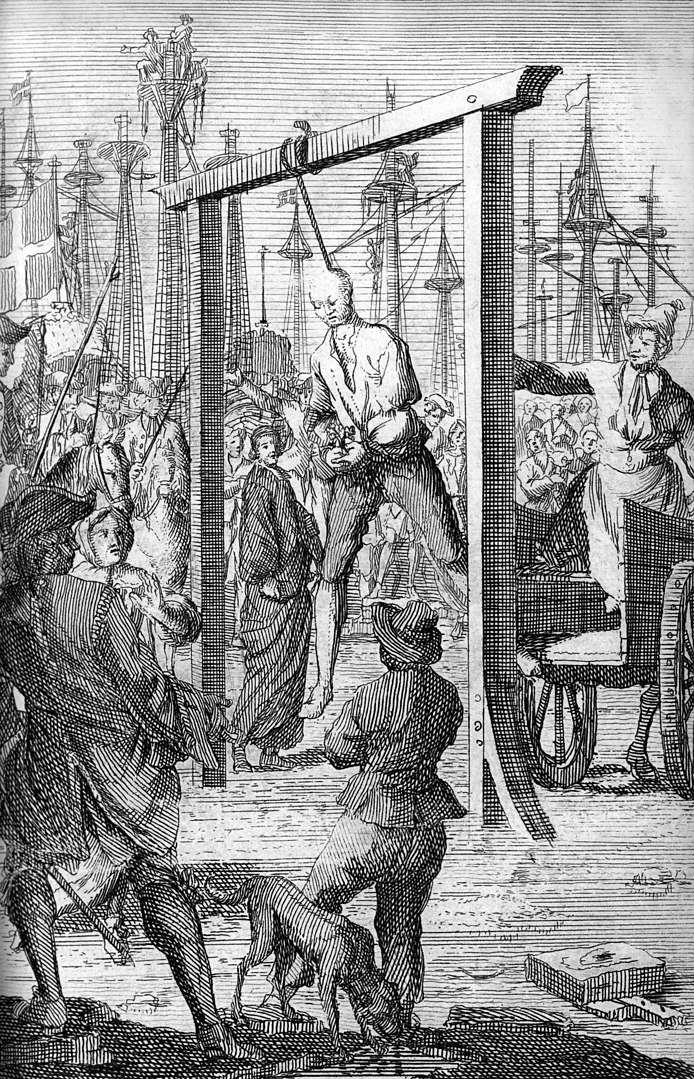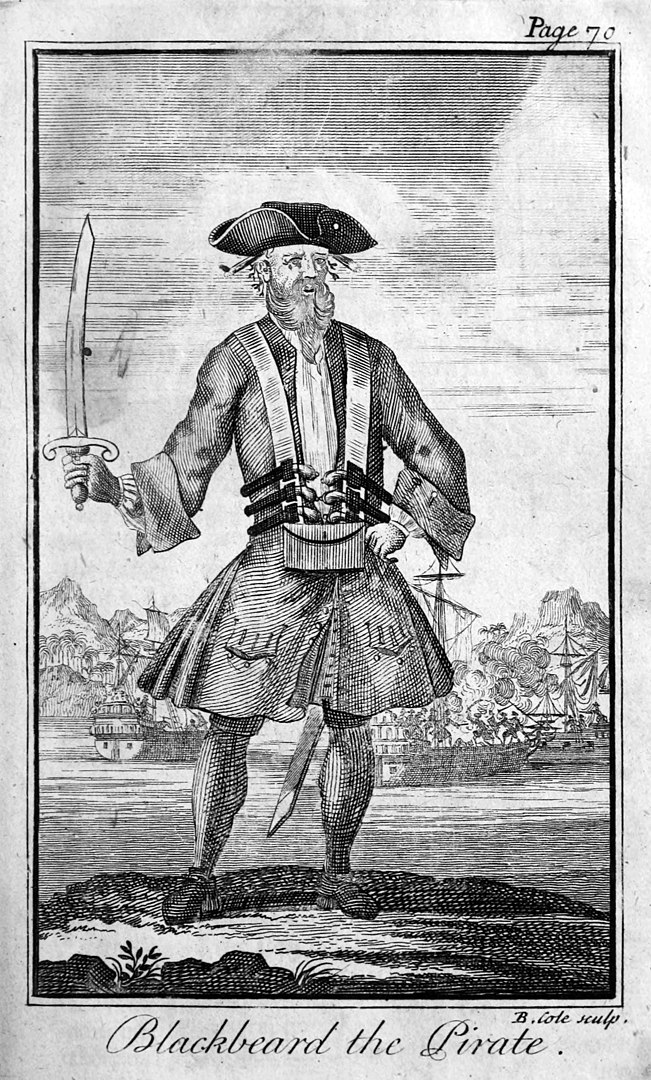Barbados: A Walk through History (Part 5)
Section 4 The Genealogy of Pirates

(Bartholomew Roberts)
Around the beginning of the 18th century, there was a pirate named Bartholomew Roberts (1682-1722) who ravaged the seas he travelled, from the west coast of Africa to the Caribbean Sea, and all the way to the east coast of South America.
Roberts, alias “Black Bart”, explained his choice of career with the reason that “In an honest service there is thin commons, low wages, and hard labour; in this, plenty and satiety, pleasure and ease, liberty and power; and who would not balance creditor on this side, when all the hazard that is run for it, at worst, is only a sour look or two at choking. No, a merry life and a short one, shall be my motto.”. There is a legend that due to a certain motive, Roberts chased after any ship he found in the Caribbean which was from Barbados, attacking and beating it to the fullest.
*********************************************
Why were pirates rampant in the Caribbean?
Upon hearing the word “Caribbean”, many people conjure up the image of pirates.
Pirates first appeared in the Caribbean Sea in the 16th century, which at this time Spain had control over the Caribbean Sea and Central America. The Valois Dynasty of France had their eyes on the riches the Spanish merchant ships were carrying; Francis I gave “permission” to French ships to attack Spanish vessels and islands in the area.
Slightly afterward English and Dutch ships also joined in on attacking Spanish vessels.
Under the rule of Elizabeth I, English armed fleets captained by men such as John Hawkins and Francis Drake (refer to Part 1 “Early History of the Coral Island”) started plundering treasure from Spanish ships, being encouraged by the Royal family.The first pirating in the Caribbean started with fighting resembling guerrilla warfare-countries who wanted to challenge Spanish dominance of the seas launched attacks on Spanish fleets with the intent to obstruct the flow of trade.
Caribbean pirates entered the “golden age” approximately one century later around the second half of the 17th century until the first half of the 18th century. During this period, Spanish influence waned while emerging powers of England, France, and the Netherlands started to establish colonies on the Caribbean islands. Sugar production dramatically increased, and in order to guarantee a steady supply of labor the slave trade started to thrive.
Ships carrying vast wealth such as silver, sugar, necessity items for the colonies, luxury items for plantation owners, and African slaves continually travelled between Europe, Africa, and the Caribbean. On the other hand, the Puritan Revolution thrust England into a civil war, three Anglo-Dutch wars took place, and the War of the Spanish Succession broke out, ensnaring numerous countries into the conflict. All of this chaos happening back home did not leave many countries with the ability to look after their merchant and slave ships crossing the Atlantic and Caribbean Sea.
Colonial islands including Barbados started to pay money to outlaw armed ships to guard their vessels for them. The majority of these outlaws not only protected the ships which employed them, but also openly plundered other ships as such actions were silently accepted. Often, these privateers gradually drifted away from the control of their employers and made pirating their full-time job. The Caribbean Sea became an “uncontrolled” place where one could make his fortune without abiding by any laws and decorum.
Bartholomew Roberts was a pirate during this period. Born in Wales, he attacked over four hundred ships in his lifetime, said to be the most successful pirate in history. When Roberts was just starting out as captain of a pirate ship, a bitter experience with a tracking ship which the Governor of Barbados sent to tail Roberts while “on duty” off the shore of Barbados left him barely escaping with his life, and with a lifelong hatred for the island.
In other words, Barbados was Roberts sworn enemy, but there were other pirates from Barbados, some of which whom I will introduce below.
The Gentleman Pirate, Stede Bonnet
There is a park called White Point Garden on the waterfront town facing the Atlantic Ocean of Charleston, South Carolina. There is a small memorial plaque inscribed with the following words:
“Near this spot in the autumn of 1718, Stede Bonnet, notorious “gentleman pirate”, and twenty-nine of his men, captured by Colonel William Rhett, met their just deserts after a trial and charge, famous in American history, by Chief Justice Nicholas Trott. Later nineteen of Richard Worley’s crew, captured by Governor Robert Johnson, were also found guilty and hanged. All were buried off White Point Gardens, in the marsh beyond low-water mark”.
This plaque is a testament to a large number of groups of pirates who were caught and executed by the local authorities of England’s North American colonies. It can be assumed that the line “all were buried…in the marsh beyond low-water mark” to mean that when the waters reached high-tide, the bodies quickly turned into a tragic sight.
The “notorious ‘gentleman pirate’ Stede Bonnet (1688-1718), inscripted onto this plaque, was in fact born in Barbados.
Bonnet was born in Christ Church parish, Barbados to a family of wealthy sugar plantation owners. Not much is known about his life from the time he lost his father early on until he became a pirate, only that he held the title of “Major”, most likely implying that he was a member of the Barbados Colonial Militia, and that he married at the age of 21. His wife was a woman named Mary Allamby, from a reputable family of the main settlement of Bridgetown, and together they had four children.
If he had stayed on this path, Bonnet would have had an easy life using African slave labor to keep his plantation running.
However, upon entering his eighth year of marriage he suddenly decided to become a pirate and took flight. The moniker “gentleman” comes from his previous life as part of the landowning class, or “gentleman” who transformed into a pirate.
There are multiple theories as to why Bonnet, with barely no experience on the seas, left his life and abruptly turned into a pirate, but according to the most prevalent theory he “got sick and tired of his life married to his exceedingly nagging wife, Mary”.
One might find this reason to be quite unbelievable, but it is written so in the book “A General History of the Robberies and Murders of the most notorious Pyrates” (commonly known as "The History of Pyrates”), published in England in 1724 (note 1). This book talks in-depth about the lives of pirates such as Bartholomew Roberts and Stede Bonnet, and this piece of literature is what created the image of pirates as “heinous, lawless men of the sea” for generations to come. It is said that Robert Louis Stevenson referenced this book for his famous novel “Treasure Island”.

(“Gentleman Pirate” Stede Bonnet)
Just like his reason for becoming a pirate, “Gentleman Pirate” Bonnet’s methods were a bit unconventional.
First off and most importantly, his ship. Pirate ships were normally either stolen merchant ships fitted for pirating use, or vessels that privateers had used which they outfitted to become authentic pirate ships. However, in comes the well-to-do landowner Bonnet. He went to the local shipyard and ordered a new sloop with ten firing cannons.
Next off were his crew. Bonnet, not having any previous connections with the pirating world, had no one to join him, so he took in 70 ne’er-do-wells as his crew. What was even more astounding was that they were not paid a percentage of pilfered goods, such as was the standard in the pirating business, but they received pay based on a wage system.
It seems as though that Bonnet’s unusual approach to pirating was implying something about the fate he would eventually meet. It may be difficult to suddenly believe that he turned to pirating to escape his nagging wife, but I believe it to be a credible theory. After all, what other meaning can be behind the name of his vessel, “Revenge”?
Nevertheless, Bonnet, who had somehow set out on this new career path, quietly left Carlisle Bay before the sunrise on a spring day in 1717.
Bonnet and Blackbeard
Bonnet succeeded in taking out a few ships as he made his way northward; moreover, he even attacked two of Barbados’ ships for what seemed to be a show to his homeland that he was plundering the seas as a pirate-it may be was hiding something deep within himself.
In the autumn of 1717, Bonnet met a fellow pirate named Edward Teach in the “pirates den” in Nassau, Bahamas. Bonnet gave the right to command the “Revenge” to Teach, and became part of his crew, due in part to unhealed injuries sustained while fighting during a looting attempt.
But more than his physical condition, Bonnet was just a richling who grew up in a deep-pocketed family who lost his confidence as head honcho after being taken advantage of by his underlings. Bonnet getting close to Teach was like a no-name yakuza boss getting close to the top leader and being well-treated; however, Bonnet chose the wrong person to lean on. Edward Teach went by another name- Blackbeard. He was born in Bristol, England, and his ruthlessness made him one of the most notorious pirates in history with novels and movies made based on his pirating life.
After ravaging the northern Caribbean for a few months together, Blackbeard and Bonnet made their way up to the North American British colony of Carolina. At this point they had four ships under their command.
The “Blockade of Charleston” is a famous historical event starring Blackbeard and Bonnet. The two pirates blocked the port of Charlestown (now called Charleston), capturing and pillaging ships in the harbor. They even went as far as to take hostages, placing demands on the authorities to deliver them medicine in return for the lives of those they had taken hostage. This was the heyday of Bonnet’s pirating career, but as the saying goes, “good things never last”, and Blackbeard’s betrayal led to Bonnet’s downfall.
One day when Bonnet had returned from a short voyage to St. Thomas (then a colony of Denmark) in order to make repairs on his ship the “Revenge”, Blackbeard, who was lying in wait for Bonnet’s return, stole the cargo onboard the ship, took most of the crew with him, and took off for the open seas, leaving Bonnet behind. Blackbeard, who had made his way up the pirating ladder from a lowly deckhand of a privateering vessel to one of the most feared pirates, considered Bonnet as just another incompetent man trying his hand at pirating. It is unclear if Blackbeard had laid out his plans to backstab Bonnet from the beginning, or if during their time together he realized that Bonnet would become a hindrance and devised this plan.
Bonnet had no choice but to take with him the few remaining crew and set off on the “Revenge”. However, all his cargo had been stolen by Blackbeard and thus had no choice but to make his way up and down the Atlantic coast, plundering miserly amounts in order to eke out a living for him and his crew.
Bonnet’s Last Days
In the summer the following year of 1718, the “Revenge” was docked in Cape Fear estuary in North Carolina, waiting for the hurricane season to pass.
Governor Robert Johnson of the colony of South Carolina flew into a rage when he had gotten wind of Bonnet’s location, as the Governor’s loss of face of the “Blockade of Charleston” was still fresh in his mind. He called on Colonel William Rhett to pursue Bonnet and his ship, and as Blackbeard had long ago disappeared, he and his one lonely ship were soon forced into a face-off surrounded by South Carolina Colonial Militia.
The winner was obvious from the start. Bonnet ordered his crew to blow up the gunpowder magazine at the bottom of the ship when Colonel Rhett gave his men the order to storm the “Revenge”. However, Bonnet’s underlings had already given up fighting, and raised the white flag in surrender. Hence Bonnet and his men were captured and taken to Charlestown.
Just as is written on the memorial in White Point Garden, Bonnet and his crew were sentenced to death by hanging. His final moments were quite despicable; at his trial he claimed that his subordinates disobeyed his orders and committed acts of piracy- a typical excuse of an incompetent manager. When he was sentenced to death, he sent Governor Johnson a letter pleading him to save his life, writing “I’ll heartily beseech you’ll permit me to live, and I’ll voluntarily put it ever out of my power by separating all my limbs from my body…”. On December 10th Bonnet was finally brought to the gallows, and when he reached the steps he created a pathetic scene and broke down sobbing, making the crowd, who were there half out of curiosity and half for entertainment, shed tears for his “terrible” predicament.
In the end, Bonnet was hanged and buried in the marsh in South Carolina, a long ways away from his native home. However, looking back on his life, only a year and a half had passed from the time he became a pirate until he met his death at the gallows. During this time his subordinates abandoned him, was backstabbed by Blackbeard, all making it seem that his life on the dark side was not much to be envied.
Bonnet may not have been good at judging a person’s character, as evidenced by his marriage to a “nagging” wife and pairing up with the cunning Blackbeard. However, no matter how much he detested his evil wife, how was it that he was desperate enough to become a pirate instead of just letting her words go in one ear and out the other, or taking a large sum of money and run away instead of becoming a pirate? Thinking about these things while researching Bonnet’s life started to give me pangs of sadness (note 2).
Speaking of the man who backstabbed Bonnet, whatever happened to Blackbeard after he stole Bonnet’s ship?
After his showdown with Bonnet, Blackbeard continued along the Atlantic coast, tearing up England’s colonies. However, he met his fate in Virginia when he was cornered by the colonial navy, and fought his enemy in a brutal combat valiantly until the end. His body was thrown into the ocean, while his head was exposed on the bow of the Virginia navy’s ship. Blackbeard met his end approximately 20 days before Bonnet was hanged in South Carolina.
(Part 4: “The Genealogy of Pirates” to be continued)

(Depiction of Bonnet’s execution)

(Blackbeard)
(Note 2) In recent years, a person claiming that their ancestor married the widowed Mrs. Bonnet after the hanging of the “Gentleman Pirate” suddenly appeared. According to this person, the reason why Bonnet became a pirate was “not to run away from his bad wife. When Bonnet was young, his mother remarried after his father passed away. His step-father ran away towards Carolina with the family’s wealth, and named his boat the “Revenge” as that was what he planned to get, heading towards Carolina.” (February 14th 2019 article in Barbados daily newspaper “Daily Nation”.) However, according to this claim, there is no explanation for Bonnet unexpectedly leaving his wife and four children to become a pirate, which makes me think that the “runaway from nagging wife” theory that was depicted shortly after his death in “The History of Pyrates” is more credible.
(This column reflects the personal opinions of the author and not the opinions of the Ministry of Foreign Affairs of Japan)
WHAT'S NEW
- 2024.12.4 UPDATE
PROJECTS
"Barbados A Walk Through History Part 14"
- 2024.9.17 UPDATE
PROJECTS
"Barbados A Walk Through History Part 13"
- 2024.7.30 UPDATE
EVENTS
"408th Lecture Meeting Regarding Global Issues"
- 2024.7.23 UPDATE
PROJECTS
"Barbados A Walk Through History Part 12"
- 2024.7.9 UPDATE
ABOUT
"GREETINGS FROM THE PRESIDENT JULY 2024"
- 2024.7.4 UPDATE
EVENTS
"APIC Supports 2024 Japanese Speech Contest in Jamaica"
- 2024.6.27 UPDATE
EVENTS
"407th Lecture Meeting Regarding Global Issues"
- 2024.5.21 UPDATE
EVENTS
"406th Lecture Meeting Regarding Global Issues"
- 2024.5.14 UPDATE
EVENTS
"405th Lecture Meeting Regarding Global Issues"
- 2024.4.2 UPDATE
PROJECTS
"Water Tanks Donated to Island of Wonei, Chuuk, FSM"




